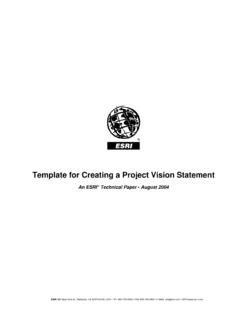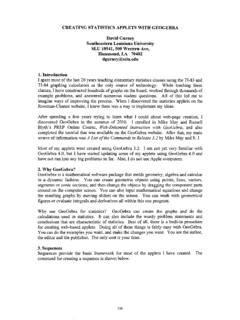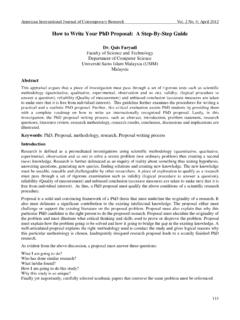Transcription of Developing a Strong Need Statement - Marshall
1 < < strong >Strongstrong > >Developingstrong >Strongstrong > > a < strong >Strongstrong > Need StatementStatement of Need Also known as problem < < strong >Strongstrong > >Statementstrong >Strongstrong > > , need < < strong >Strongstrong > >Statementstrong >Strongstrong > > , or < strong >needsstrong > assessment < < strong >Strongstrong > >Statementstrong >Strongstrong > > of need establishes the focus and rationale for the grant proposal or projectStatement of Need If you do not have a compelling need, you do not have a compelling project The < < strong >Strongstrong > >Statementstrong >Strongstrong > > of need is a concise and coherent < < strong >Strongstrong > >Statementstrong >Strongstrong > > , supported by evidence, on why the project < strong >needsstrong > to be undertaken The < < strong >Strongstrong > >Statementstrong >Strongstrong > > of need drives everything else that is in the grant proposalGeneral Rules Don t use jargon Spell out acronyms Don t assume reviewer knows about the conditions that prompted the project Don t editorialize state facts Need should be based on rational terms, not on emotional appealsGeneral Rules Avoid circular reasoning (stating the absence of your solution as the problem) For example: The problem is that we have no youth center. The solution is to build a youth center.
2 General Rules How do you know that the absence of a youth center is a problem? What kind of evidence (data) do you have to back that up? Remember: Your solution is not your problemGeneral Rules Make sure < < strong >Strongstrong > >Statementstrong >Strongstrong > > of need is locally based and focused The need/problem may be a national problem as well, but make sure that you establish that it is a local problem through relevant data Don t assume that a national problem is automatically a local problemGeneral Rules Like your whole grant proposal, your < < strong >Strongstrong > >Statementstrong >Strongstrong > > of need should be: Concise (stick to the main points) Complete (include everything asked for) Coherent (provide a logical case for your need/problem) < < strong >Strongstrong > >Statementstrong >Strongstrong > > of Need < < strong >Strongstrong > >Statementstrong >Strongstrong > > of need should answer the following questions: < < strong >Strongstrong > >Statementstrong >Strongstrong > > of Need What is the problem/need? How do you know it is a problem? < < strong >Strongstrong > >Statementstrong >Strongstrong > > of need should be supported by evidence (qualitative or quantitative data) The data should be current, not out-of-dateStatement of Need Sources of statistics on the internet: of Need Other sources of data collection: Surveys/need assessments Local colleges/universities Regional Planning/Development Councils Local libraryStatement of Need Always use comparative data For example: The poverty rate in Acme County is 15% (Nothing to compare the county rate with) Comparative: The poverty rate in Acme County is 15%, compared with 12% in the state and nationally < < strong >Strongstrong > >Statementstrong >Strongstrong > > of Need What is the target population that you are trying to help?
3 Describe the target population and the < strong >needsstrong > /conditions of that populationStatement of Need Don t confuse your organization s < strong >needsstrong > with the < strong >needsstrong > of your target population Funders do not fund your organization s < strong >needsstrong > , they fund what your organization can do to help your community Don t forget: The need is in your community/region, show the impact thereStatement of Need Is the problem/need urgent? Why does it need to be addressed now? < < strong >Strongstrong > >Statementstrong >Strongstrong > > of Need Why should it be your organization that addresses the problem/need? Make sure that the problem/need relates to the purpose and mission of your organization (and state this in your proposal)Recap on Four Questions What is the need/problem? How do you know it is a need/problem? What is the target population that you are trying to help? Is the problem/need urgent? Why does it need to be addressed now? Why should it be your organization that addresses the problem/need?
4 < < strong >Strongstrong > >Statementstrong >Strongstrong > > of Need (Examples) Our youth have limited access to educational resources. They are mostly from low-income households, and the neighborhood in general is very distressed. We have one after-school program that is well attended, but we need more resources to reach more of our students. Please help us educate our youth. < < strong >Strongstrong > >Statementstrong >Strongstrong > > of Need (Examples) Problems with this < < strong >Strongstrong > >Statementstrong >Strongstrong > > of need: No data or evidence Emotional appeal rather than rational How do you know that they are mostly from low-income households? How do you know the neighborhood in general is distressed? < < strong >Strongstrong > >Statementstrong >Strongstrong > > of Need (Examples) According to the National Acme Education Center, 45% of middle school students across the nation do not have access to after-school programs, and in our state the figure rises to 58%. The same source also pointed out that our state education budget is being cut by 12%.
5 These are trends that the students in our community must be able to overcome. < < strong >Strongstrong > >Statementstrong >Strongstrong > > of Need (Examples) Problems with this < < strong >Strongstrong > >Statementstrong >Strongstrong > > of need: Does not focus on local conditions (is there an after-school program or other resources in the community?)Conclusion < < strong >Strongstrong > >Statementstrong >Strongstrong > > of need should be backed up by evidence Use comparative data Watch for circular reasoning Don t confuse your < strong >needsstrong > with your target population s < strong >needsstrong > Be concise and localize your









